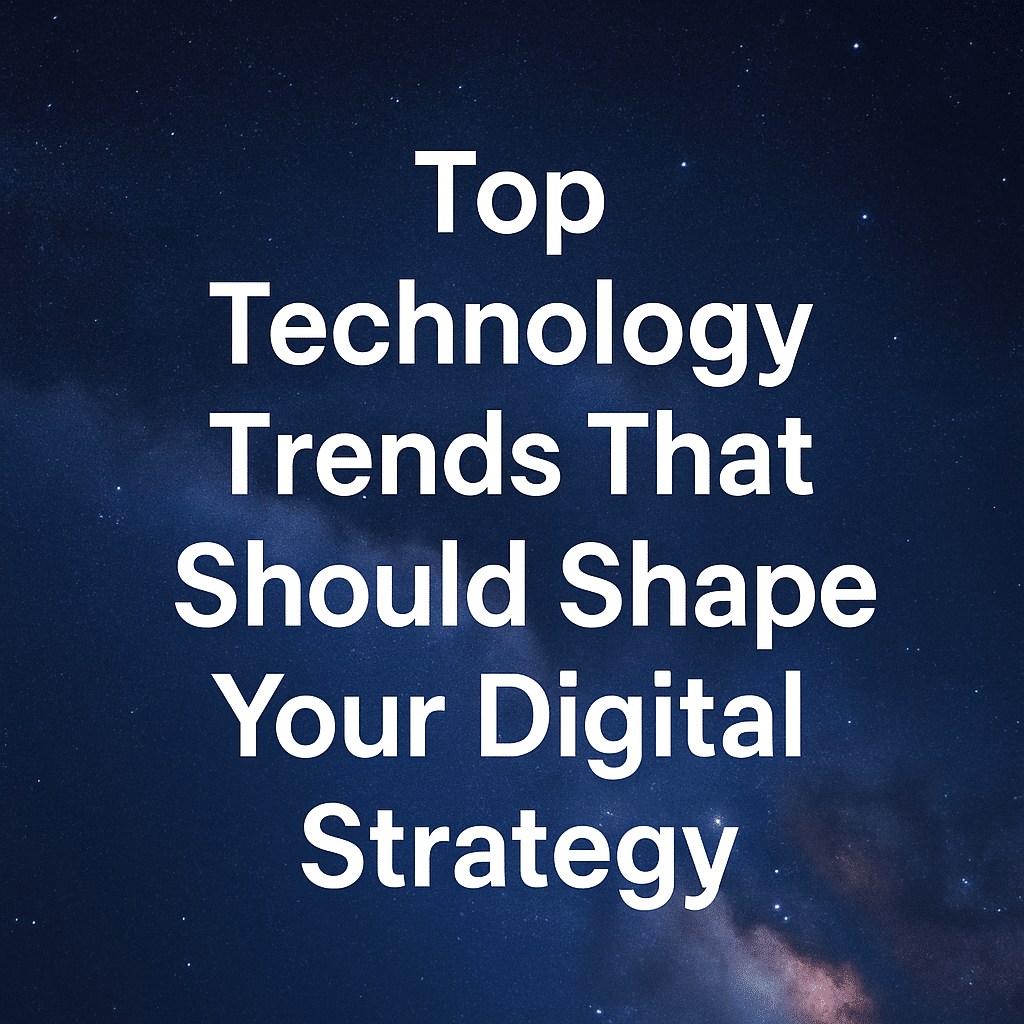Table of Contents
ToggleWhy Digital Strategy Starts with the Right Technology Trends
As digital transformation accelerates, leaders are asking the right question: Which technology trends should guide our digital strategy? The answer isn’t just about adopting the flashiest tools—it’s about building a strong, flexible foundation that enables sustainable change.
Whether you’re migrating to the cloud or evaluating AI-driven ERP systems, success depends on understanding the building blocks of a modern tech stack—and how they interact over time.
In this blog, we break down the most important technology trends shaping digital strategy in 2025—and how to avoid common missteps.
1. Cloud Migration (But With Clarity)
Cloud is not a trend—it’s the foundation of your future systems. But many organizations rush into cloud ERP or infrastructure without fully understanding:
- The difference between public vs. private cloud
- Vendor lock-in risks
- How cloud platforms connect to data and application layers
Choosing a cloud platform isn’t just an IT decision—it shapes your entire tech stack for years to come. Organizations must align their cloud provider choice with long-term goals around flexibility, scalability, and total cost of ownership.
2. Integration Is the Real MVP
Modern digital strategies are built like Legos—a modular stack of apps, data services, and user interfaces. But what glues those blocks together is integration.
Organizations must invest in:
- Middleware platforms
- API management tools
- Flexible architecture that allows components to be swapped or upgraded over time
Poor integration is often the silent killer of transformation success. The ability to adapt, expand, and innovate depends on this invisible—but critical—layer of your infrastructure.
3. A Strong Infrastructure Layer
Think of your infrastructure like the foundation of a house. If you build on sand, your digital strategy will sink.
Critical questions to ask:
- Can our infrastructure support rapid change?
- Is it optimized for performance across global teams?
- How do our infrastructure decisions limit or enable future software investments?
In many cases, the choice of infrastructure provider ends up dictating the choice of ERP—especially as more vendors align tightly with cloud hyperscalers like AWS, Azure, or Google Cloud.
4. Aligning Software with Infrastructure and Data
Software selection is no longer about features alone. As platforms evolve, alignment between software, data models, and cloud provider ecosystems becomes critical.
In one recent client case, the organization chose its ERP not because it had better features, but because it worked better with its existing cloud infrastructure investment. That tight integration was the game-changer in their decision-making process.
Organizations must now evaluate:
- Who owns each layer of the stack (platform vs. software)
- Whether your data is portable and accessible
- How your system handles cross-platform workflows
Download our 2025 ERP Software Selection Guide
5. Data Visibility & Business Intelligence
While flashy tech gets the attention, data visibility remains a top priority. Organizations want a 360-degree view of operations, customers, and supply chains—especially in volatile markets.
Key capabilities gaining traction:
- Business Intelligence Dashboards
- Customer 360 and Supplier 360
- Self-service reporting tools
Having data is one thing. Knowing how to interpret and act on it—without IT intervention—is what separates digital leaders from the rest.
6. IoT, Self-Service, and the Expanding Ecosystem
The future of enterprise systems is connected, automated, and accessible.
Trends like the Internet of Things (IoT) and self-service ERP portals are becoming table stakes. Suppliers want real-time status updates. Customers want to manage accounts directly. Leaders want predictive insights from connected devices.
These capabilities are no longer futuristic—they’re expected.
Learn how ERP systems are evolving in our Top ERP Trends Report
7. Strategy and Roadmaps Are Now a Trend
Ironically, one of the most important “technology trends” is not about technology at all—it’s about strategy.
Companies of all sizes—especially SMBs—are now investing in:
- Digital strategy workshops
- Enterprise architecture planning
- Business case development and ROI modeling
For small organizations especially, a weak strategy can be the difference between growth and extinction. One recent client’s digital immaturity was killing supply chain visibility—until they developed a holistic strategy that tied international shipping systems, ERP, and customer portals into a cohesive plan.
Book a digital strategy assessment with our team at Third Stage Consulting
Frequently Asked Questions (FAQ)
What is the most important technology trend for 2025?
Cloud migration—with a focus on integration, scalability, and long-term infrastructure alignment—is the top trend shaping digital strategy today.
How can businesses avoid vendor lock-in with cloud ERP?
By prioritizing open architecture, strong middleware, and selecting providers with a clear data exit strategy. Avoid overly proprietary stacks.
Why is integration so critical in digital transformation?
Because disconnected systems lead to data silos, poor reporting, and project delays. Integration ensures that your platforms communicate seamlessly across all functions.
Are small businesses investing in digital strategy?
Yes. More SMBs are recognizing that digital transformation isn’t just for enterprise firms. Strategic planning is now viewed as essential for survival.
What are some tools organizations are adopting for better visibility?
Power BI, Tableau, Qlik, and customer/supplier self-service portals are being used to increase access to real-time operational insights.






